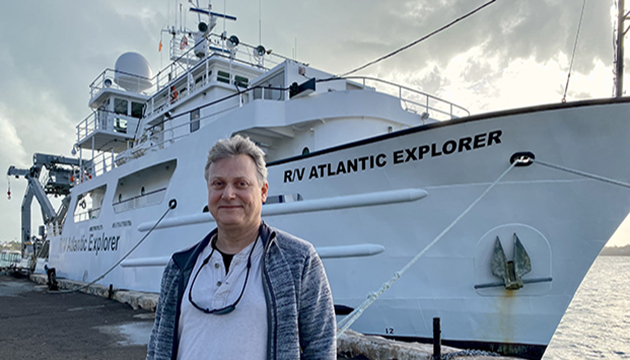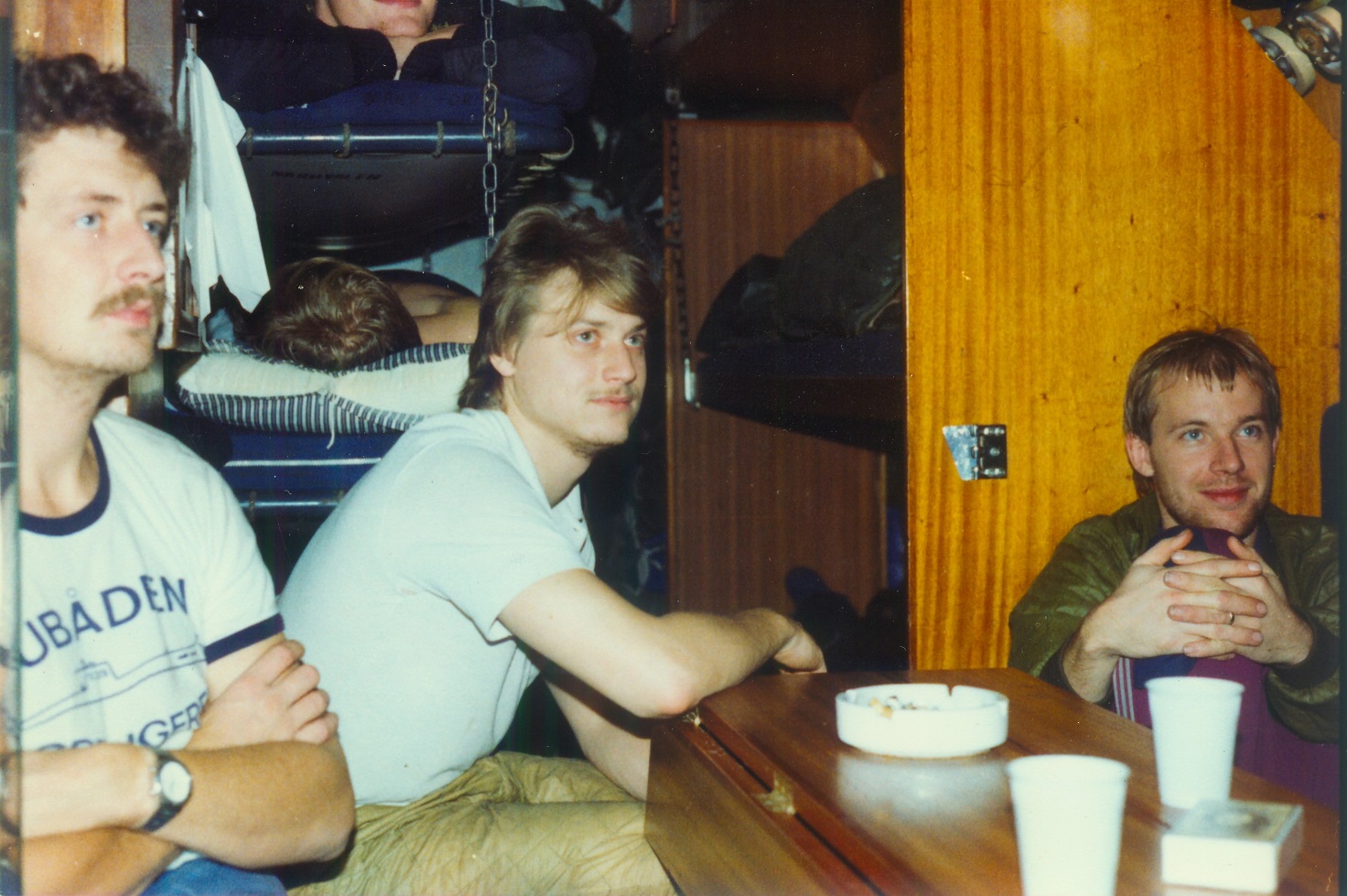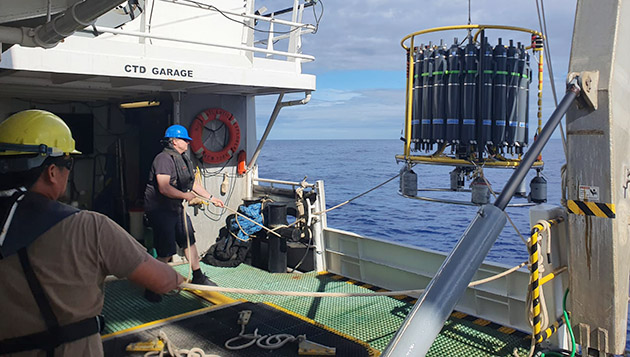Posted in:
A Career of Submarines, Yachts, and Research Vessels

A native of Denmark, Kent Larsen brings to BIOS more than 35 years of experience in electronics, audio-visual, communications and information technology that he gained from working in both maritime and shore-based roles.
Since late 2019, Kent Larsen has served as the oceanographic technical services manager for the BIOS-operated research vessel Atlantic Explorer. It’s a vital role, as modern oceanographic research ships have huge electrical and electronic requirements with complex technology to support their communications systems. His responsibilities include maintaining the audio-visual, electronic, and technical systems on board the ship, from satellite communications and navigational systems to the bridge (the ship’s command center) to emergency and surveillance systems.
A native of Denmark, 57-year-old Larsen brings to BIOS more than 35 years of experience in electronics, audio-visual, communications and information technology that he gained from working in both maritime and shore-based roles. His area of expertise is in technical troubleshooting and the planning, budgeting, and supervision of shipyard refit and refurbishment projects.
On shore at BIOS, he has gained a reputation for his quick thinking and technical skills. “Kent was my ‘emergency responder’ last year, after I blew up two lab computers by connecting them to a new, custom-built instrument,” said BIOS faculty member and marine ecologist Yvonne Sawall. “He dropped everything to have a look at the problem, did some electric measurements, and told me what to take care of in the future. Since then I haven’t had the same problem.”
For researchers working at sea, they rely on his calm composure to make their science possible. His diverse experience on a range of vessels, from yachts to naval submarines, has proved invaluable.
“Not marine science-related, but one of my most intense moments was during my time in the Royal Danish Navy when I was aboard a Danish submarine during a large joint NATO exercise in the Baltic Sea,” Larsen said. “I had only two hours to fix a fried passive sonar system, without which the boat could not dive. If I had not managed to repair it in time we would have had to pull out of the whole operation. So that was a lot of pressure.”
“It is a challenging role,” he said, “but the troubleshooting and problem solving is what I like best about my work.”

Larsen (center) served with 33 others on the submarine Narhvalen. In this 1988 photo they were on patrol in the Baltic Sea. “The only person who had his own bunk was the captain,” he said. “I was the main depth helmsman when we were submerged, along with my technical work and maintenance.” (Photo courtesy of Kent Larsen)
You are a certified Electro-Technical Officer, or ETO. How did you train for this position?
I honed my craft while serving 15 years as a submariner and instructor in electronic engineering in the Royal Danish Navy. I also hold the trainings and certifications necessary to work on all sizes of ships as an ETO. There are not many issues that I have not encountered before.
How did your work not in only in the Navy, but also on luxury yachts, prepare you for work at BIOS?
I worked aboard several privately-owned, luxury motor yachts, each more than 300 feet in length, which were used for leisure trips and sometimes for business meetings. All of these positions were rotational; meaning, I would work for 10 weeks to three months at a time and then take the equivalent time off.
I was fortunate to visit many amazing and varied destinations during that time, including many European countries, as well as Alaska, the Maldives, Egypt, Qatar, Gibraltar, Costa Rica, and Greenland. I have also visited most of the Caribbean islands. During my travels I sailed through the Kiel, Panama, Suez, and Corinth Canals. In 2017, while on board the last yacht, I even visited Bermuda for a month.
Yacht owners have high expectations for their vessels, especially when it comes to the entertainment systems and information technology capabilities essential for luxury cruising. Ensuring the consistent reliability of all the electronic systems on a yacht is actually great preparation for working at BIOS, as I believe that “only the best will do” is a good baseline approach to any job.

In July 2020, Larsen (in blue hat) accompanied the crew of Atlantic Explorer to assist with a cruise southeast of Bermuda. “At that time, we only had one marine science technician available and every cruise requires at least two, so I was assisting until the two newly hired technicians had gained experience and could take over,” he said. “I still go out on cruises as needed.” (Photo by Rory O’Connell)
What appealed to you about the position at BIOS?
I was a regular visitor to the island since the summer of 2011, when I met my future wife, Audrey Pope, a BIOS employee who is also Bermudian. We married in 2017 when I was still spending months away at sea. But the island, and in particular the town of St. George’s, had become my “home away from home.” In 2019 the position with Atlantic Explorer became available. I left yachting to live and work in Bermuda full-time.
I had also previously served as ETO aboard two Schmidt Ocean Institute research vessels. This was the perfect opportunity for me to return to working in the field. It also allows me to have a mostly shore-based job while still maintaining my official seaman’s status.
How are you adjusting to a shore-based role?
I still spend some time at sea when technical coverage is needed on research cruises, but not for the long periods as in the past. I enjoy being on board Atlantic Explorer, working with such a professional team of three marine technicians and the ship’s crew. Being on deck and involved first-hand with the sampling and equipment deployments for important long-term BIOS research programs such as the Bermuda Atlantic Time-series Study, the Bermuda Institute of Ocean Sciences – Simons Collaboration on Ocean Processes and Ecology Study, and the Oceanic Flux Program is a special experience, especially on days when the sea is flat and calm.
I am also co-principal investigator for the National Science Foundation grants that support the vessel which involves proposal writing and budgeting. It has been a big personal adjustment to work year-round rather than having so much free time and travel opportunities.
How would you describe your approach to your job?
I am old-school in my approach to maintaining and fixing equipment; I do my best to repair equipment and diagnose any electronic or technical problems first before spending operating funds on spare parts or replacements. That said, I also believe that the latest technology and software should be made available for ship clients, and that the scientists and marine technicians should have the reliable equipment necessary for a successful research cruise.
What are your goals for your position at BIOS?
My most immediate goal is to ensure that the current shipyard maintenance period for Atlantic Explorer in Jacksonville, Florida, goes according to plan as far as the equipment overhaul and technical upgrades are concerned.
I enjoy passing along my knowledge and mentoring the next generation of technicians, so I would like to expand that aspect of the job in the future, perhaps with some dedicated training courses.
At some point I also hope to create some standardized instructional and operating manuals for the ship’s technical operations. BIOS is an internship placement site for the Marine Advanced Technology Education (MATE) Program, so I am looking forward to hosting some of their interns again this year. While living and working aboard the ship they gain valuable experience and skills to prepare them for a career supporting scientific research at sea.
Tagged:


